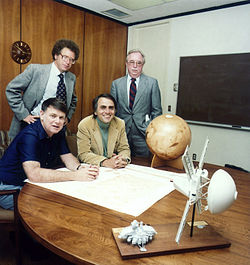From Wikipedia, the free encyclopedia
| Type | NGO and Non-profit foundation |
|---|---|
| Fields | Space advocacy |
Members
|
40,000+ |
Key people
|
Carl Sagan, Bruce C. Murray, Louis Friedman, Bill Nye, Neil deGrasse Tyson |
| Mission | To inspire the people of Earth to explore other worlds, understand our own, and seek life elsewhere. |
| planetary |
The Planetary Society is an American-based non-government, nonprofit organization; anyone can join. It is involved in research and engineering projects related to astronomy, planetary science, exploration, public outreach, and political advocacy. It was founded in 1980 by Carl Sagan, Bruce Murray, and Louis Friedman,[1] and has over 40,000 members[citation needed] from more than one hundred countries around the world.
The Society is dedicated to the exploration of the Solar System, the search for Near Earth Objects, and the search for extraterrestrial life.[2] The society's mission is stated as: "To empower the world's citizens to advance space science and exploration".[3]
In addition to public outreach, the Planetary Society also sponsors novel and innovative projects that will "seed" further exploration. In June 2005, the Society launched the Cosmos 1 craft to test the feasibility of solar sailing, but the rocket failed shortly after liftoff.[4][5]
The Planetary Society runs many
LIFE was a two-part program designed to test the ability of microorganisms to survive in space.[8] The first phase flew on shuttle Endeavor's final flight in 2011.[9] The second phase rode on Russia's Fobos-Grunt mission, which attempted to go to Mars' moon Phobos and back but failed to escape earth orbit. [10]
In addition to its projects, The Planetary Society is also a strong advocate for space funding and missions of exploration within NASA. They actively lobby Congress and engage their membership in the United States to write and call their representatives in support of NASA funding.
History
The Planetary Society was founded in 1980 by Carl Sagan, Bruce Murray, and Louis Friedman as a champion of public support of space exploration and the search for extraterrestrial life. Until his death in 1996, the Society was actively led by Sagan, who used his celebrity and political clout to influence the political climate of the time, including protecting SETI in 1981 from congressional cancellation. Throughout the 1980s and 1990s, the Society pushed its scientific and technologic agenda, which led to an increased interest in rover-based planetary exploration and NASA's New Horizons mission to Pluto.In addition to its political affairs, the Society has created a number of space related projects and programs. The SETI program began with Paul Horowitz's Suitcase SETI and has grown to encompass searches in radio and optical wavelengths from the northern and southern hemispheres of the Earth. SETI@home, the largest distributed computing experiment on Earth, is perhaps the Society's best-known SETI project. Other projects include the development of the Mars Microphone instrument which flew on the failed Mars Polar Lander project, as well as the LightSail-1 project, a solar sail project to determine if space travel is possible by using only sunlight.
Program summary
The Planetary Society currently runs seven different program areas with a number of programs in each area:- Advocacy and education
- Extrasolar planets
- Innovative technologies
- International mission participation
- Mars exploration
- Near-Earth objects
- Search for extraterrestrial life
Organization
The Planetary Society is governed by a 17-member volunteer board of directors chosen for their passion about and knowledge of space exploration. The Board has a chairman, President, and Vice President and an Executive Committee, and normally meets twice per year to set the Society's policies and futureMembers
The Planetary Society's current board of directors includes the following:[11]- Daniel Geraci, chairman of the board
- Jim Bell, President
- Heidi Hammel, Vice President
- Bill Nye, Executive Director
- Louis D. Friedman, Secretary-Treasurer of the Board
- G. Scott Hubbard
- C. Wallace Hooser
- Neil deGrasse Tyson
- Lon Levin
- Alexis Livanos
- John Logsdon
- Bijal (Bee) Thakore
- Christopher McKay, Advisory Council Chair
- Buzz Aldrin
- Richard Berendzen
- Jacques Blamont
- David Brin
- James Cantrell
- Franklin Chang-Diaz
- Frank Drake
- Owen Garriott
- Bruce Jakosky
- Tom Jones
- Sergei Kapitsa
- Charles Kohlhase
- Laurie Leshin
- Jon Lomberg
- Rosaly M. Lopes
- Hans Mark
- Yanusori Matogawa
- Risto Pellinen
- Robert Picardo
- John Rhys-Davies
- Kim Stanley Robinson
- Donna Shirley
- Kevin Stube
Science and Technology
The Planetary Society sponsors science and technology projects to seed further exploration. All of these projects are funded by the Society's members and donors. Some projects include:- Earthdials
- FINDS Exo-Earths
- Micro-Rovers for Assisting Humans
- Mars Climate Sounder
- Pioneer anomaly
- Near-Earth Objects Research
- Planetrek
- Laser Bees
- Search for Extraterrestrial Life
- Solar sailing with Cosmos 1 and LightSail-1
- Living Interplanetary Flight Experiment
- SETI@home[14]
The Planetary Report
The Planetary Report is the quarterly internationally recognized flagship magazine of The Planetary Society, featuring articles and full-color photos to provide comprehensive coverage of discoveries on Earth and other planets. It went from bimonthly to quarterly with the June (summer solstice) 2011 issue.This magazine reaches over 40,000 members of The Planetary Society all over the world, with news about planetary missions, spacefaring nations, space explorers, planetary science controversies, and the latest findings in humankind's exploration of the solar system.
